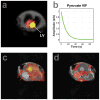Kinetic Modeling and Constrained Reconstruction of Hyperpolarized [1-13C]-Pyruvate Offers Improved Metabolic Imaging of Tumors
- PMID: 26420214
- PMCID: PMC4651725
- DOI: 10.1158/0008-5472.CAN-15-0171
Kinetic Modeling and Constrained Reconstruction of Hyperpolarized [1-13C]-Pyruvate Offers Improved Metabolic Imaging of Tumors
Abstract
Hyperpolarized [1-(13)C]-pyruvate has shown tremendous promise as an agent for imaging tumor metabolism with unprecedented sensitivity and specificity. Imaging hyperpolarized substrates by magnetic resonance is unlike traditional MRI because signals are highly transient and their spatial distribution varies continuously over their observable lifetime. Therefore, new imaging approaches are needed to ensure optimal measurement under these circumstances. Constrained reconstruction algorithms can integrate prior information, including biophysical models of the substrate/target interaction, to reduce the amount of data that is required for image analysis and reconstruction. In this study, we show that metabolic MRI with hyperpolarized pyruvate is biased by tumor perfusion and present a new pharmacokinetic model for hyperpolarized substrates that accounts for these effects. The suitability of this model is confirmed by statistical comparison with alternates using data from 55 dynamic spectroscopic measurements in normal animals and murine models of anaplastic thyroid cancer, glioblastoma, and triple-negative breast cancer. The kinetic model was then integrated into a constrained reconstruction algorithm and feasibility was tested using significantly undersampled imaging data from tumor-bearing animals. Compared with naïve image reconstruction, this approach requires far fewer signal-depleting excitations and focuses analysis and reconstruction on new information that is uniquely available from hyperpolarized pyruvate and its metabolites, thus improving the reproducibility and accuracy of metabolic imaging measurements.
©2015 American Association for Cancer Research.
Conflict of interest statement
Authors have no conflicts of interest to report.
Figures







References
-
- Warburg O. On the origin of cancer cells. Science. 1956;123(3191):309–14. - PubMed
Publication types
MeSH terms
Substances
Grants and funding
LinkOut - more resources
Full Text Sources
Medical

